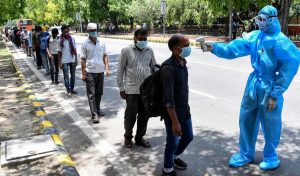India’s COVID-19 situation seems to be improving. Daily infections, which peaked in mid-September, have been declining over the past month. However, this trend could change in the coming weeks with the country entering a month of festivities.
Three major festivals — Dasara/Durga Puja, Eid, and Diwali — will be celebrated across the country in the coming weeks (Dasara celebrations have already begun). The festivals will see crowding in markets, places of worship, and public spaces, and people are unlikely to follow norms of social distancing and wearing of masks.
This is expected to set off a “tsunami” of infections, doctors have warned.
As of October 19, India had reported 7,550,273 cases of COVID-19. The country has the second largest caseload of infections in the world, just behind the United States. There have been 114,765 fatalities so far.
India reported its first case of COVID-19 on January 30. Initially, the rise in cases was slow. In fact during the initial months of the pandemic, India was among the better performers in the world with regard to containing the coronavirus.
Then the numbers began to soar. On August 7, India’s COVID-19 tally crossed the 2 million mark. It crossed 3 million on August 23, 4 million on September 5, 6 million on September 28, and 7 million on October 11. In a span of a little over a month, the country’s total coronavirus infections had doubled.
Recent weeks have seen some positive developments. Daily new infections, which peaked in mid-September, have been declining consistently. Between September 9 and 15, India added 92,839 new cases on an average every day. This dropped to 70,114 in the October 7-13 period.
On October 18, India reported 61,871 new infections.
The doubling time for cases has increased. If it took 25.5 days for the number of infections to double in mid-August, this has now increased to 73 days, according to a statement issued by the Ministry of Health and Family Welfare.
India’s recovery rate is improving too; it has grown from 76.61 percent in end August to over 87 percent at present. Besides, not only is its coronavirus-related fatality rate among the lowest in the world but that rate is also declining as well. From 3.33 percent on June 18, India’s fatality rate has dropped to 1.52 percent now.
All these hard-won improvements in containing the pandemic and limiting its deadly impact are in peril now.
Doctors have written to West Bengal Chief Minister Mamata Banerjee warning that “any laxity in maintaining health protocols” in the festival period “can be suicidal.” The “situation can spiral out of control.”
The experience of the southern state of Kerala is instructive in this regard. It was in Kerala that the first case of COVID-19 was detected in India. The state has a high population density and a large migrant population, working in other Indian states and abroad. Many of these migrants, including expatriate workers in Gulf countries, began returning home. These made the state vulnerable to infections.
Yet the Kerala government was able to contain infections. Its swift preparation for the pandemic and strict implementation of COVID-19 protocols saw it emerge as a “model” to emulate and earned it praise worldwide.
However, all that changed in September.
Kerala celebrated the Onam festival between August 22 and September 2. During that period, thousands of people flocked to temples and each other’s homes. Few wore masks or observed social distancing norms. Its impact was swift.
In early September Kerala’s average daily infections was around 2,000; it surged to nearly 8,000 in the last week of the month. On October 19, the state reported 10,606 new infections, the highest single-day spike so far.
In June, the state accounted for just 1 percent the country’s COVID-19 caseload. This rose to 3 percent in September and 10 percent this month. Kerala is home to 2.6 percent of India’s population.
The sharp surge in infections that Kerala has experienced since Onam should prompt other states to enforce strong social distancing measures in the coming month. They are unlikely to, however, as such steps would be unpopular. Bihar will be voting in state assembly elections between end of October and early November and West Bengal in mid-2021. Durga Puja is West Bengal’s main festival and a hugely popular one. Political parties will not want to draw public ire by imposing restrictions on celebrations.
Winter is approaching and this is expected to trigger another wave of infections in the coming months.
Perhaps the current declining trend in COVID-19 infections represents only the end of one wave of the pandemic in India. The worst could lie ahead.

































